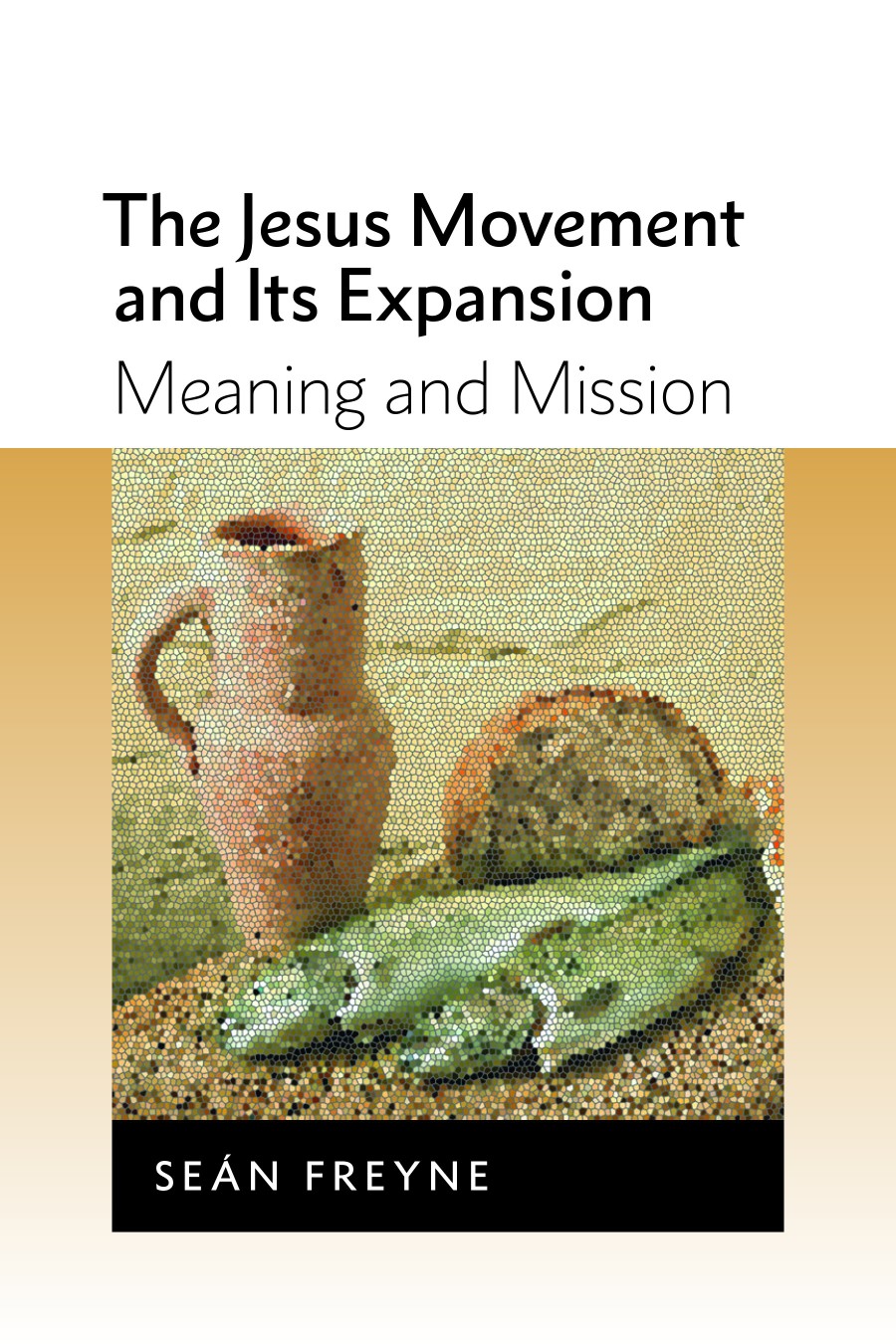The Jesus Movement and Its Expansion is the final work by the late Seán Freyne, who at the time of his death was Emeritus Professor of Theology at Trinity College, Dublin. Freyne is best known for his contributions to the knowledge of the social, economic, and religious history of Galilee in the Second Temple period. The Jesus Movement stands as a capstone to his earlier publications, revising and building upon them to offer fresh, engaging, and helpful insight into the first-century world in which Jesus and his followers lived.
The book’s eight chapters are divided into three sections. The first three chapters discuss first-century Galilee, establishing the historical and cultural contexts in which Christianity had its origins. Chapter four stands alone, exploring components of Jesus’ ministry through the contextual lens provided by the preceding material. Finally, chapters five through eight examine the geographic expansion and theological development of Christianity into the second century. The study is unified by Freye’s intention to demonstrate the rootedness of the Jesus movement in the world of Judaism, and to explore the social, economic, political and religious factors that led to diversity within Christianity from its earliest days.
In chapter one, Freyne discusses the socio-cultural development of Galilee in the Second Temple period. He challenges the accuracy of the epithet “Galilee of the Gentiles,” arguing that from at least 100 BCE the region saw a significant influx of Judean settlers. Though they were surrounded by Greek cities, the Galilean Jewish population nevertheless maintained important cultural and religious connections to Judea and, in particular, Jerusalem.
The second chapter deals with the Roman presence in Galilee and Judea, examining in particular its social and economic aspects. Freyne focuses on the rule of Herod the Great and his sons and their attempts to spread imperial ideology in the region while maintaining Jewish support. The buildup to the Jewish revolt of 66 CE is also discussed, as are the repercussions of the cataclysmic events of 70 CE for both the Jewish and Christian communities.
Chapter three examines the economy of first-century Palestine under the Hasmonean rulers, as it developed into a system which was exploited by the ruling elite. Freyne challenges the belief that there was chronic poverty in Roman-era Galilee, but acknowledges that “internal fissures” (111) between the aristocratic minority and the land-working majority only expanded once Roman interests were added to the mix. There was a fundamental difference between “the principles of egalitarianism and communal solidarity that were at the heart of Israel’s social organization” and the “patron-client dynamic” (124) that controlled Roman society.
In chapter four, Freyne situates the ministry of Jesus against this contextual background. Having earlier claimed that Galilee was associated with the lost tribes of Israel and Jewish hopes for eschatological restoration, Freyne argues that the connection between the early Jesus movement and Galilee suggests that Jesus saw himself as a prophet of renewal. He also contends that Jesus used both wisdom and apocalyptic traditions to address the widespread tension between the allegiance of the Jewish people to their central symbols (Temple, Torah, Land), and their awareness that the guardians of these symbols were complicit in the political and economic deprivation they experienced.
Freyne then turns his attention to the early Christian movement. In chapter five, he demonstrates that the Christian belief that the messianic age had begun with Jesus meant that a presence in Jerusalem “was both expected and demanded” (202). Freyne then discusses Ben Meyer’s work on the emergence of the “Hebrew” and “Hellenist” groups, arguing that the differences between the two were not doctrinal, but the result of their distinct “cultural and religious horizons” leading to “different construals of the purpose of Jesus’ life and ministry” (242). This leads Freyne to examine the leadership role of Jesus’ brother James, his connection to the Hebraioi, and his importance to “all branches of developing Christianity” (232).
Chapters six and seven both analyze the ways in which the early Christians navigated the “competing religious, social, and political interests” (243) of first and second-century Galilee. Freyne focuses on three particular issues: the interpretation of Jesus’ life and ministry; the relationship to contemporary Judaism(s); and the mission to the Gentiles. Chapter six examines these issues in three sources with (according to Freyne) pre-revolt Galilean origins: Q, the Gospel of Thomas, and the Didache. Chapter seven then explores the same three issues in the gospels of Mark and Matthew––both of which, Freyne contends, can be traced to post-revolt Galilee. Mark, utilizing the genres of Greco-Roman bios and Jewish apocalyptic, offered an account of God’s continuing presence in the world after the Temple’s destruction. Matthew focused on establishing the prophetic roots of his Jesus narrative, in order to strengthen the Christian claim among competing post-70 CE versions of Judaism.
Finally, in chapter eight Freyne traces components of Christianity’s development into the second century. He discusses the relationship between Christians and imperial power, struggles with “internal factionalism” (317), and the developing position of the church vis-à-vis Judaism. Noteworthy aspects of the chapter include the discussion of the opposition to Christianity made by the philosopher Celsus; the perspective upon Judaism represented in the Epistle of Barnabas, Justin’s Dialogue with Trypho, and Origen’s Contra Celsum; and the exploration of the connection between the development of Christian orthodoxy and the challenges posed by “heretical” movements. Freyne argues that Christianity, which began as a “multifaceted reality” (351) strongly connected to its Jewish heritage, became, by the time of Constantine, much more doctrinally homogenous and separated from its Palestinian beginnings.
The Jesus Movement is a fitting conclusion to Freyne’s academic career. It demonstrates his masterful knowledge of first-century Galilee, and his ability to critically apply historical data (derived from archaeology, epigraphy, numismatics, etc.) to deepen our understanding of the historical Jesus, biblical texts, and development of the early church. A lifetime of scholarship enables Freyne’s analysis to rise above similar studies, in terms of both clarity and application. The book’s strongest components are its thorough discussion of the social, economic, and political contexts in the first three chapters, and the particularities of Freyne’s focus on the continued influence of the Hebraioi in the early church.
However, the vast scope of this study leads to a couple of shortfalls. First, it was at times difficult to trace connections between the various parts of the book––the guiding thesis is not always clear. Occasionally, the reader is overwhelmed with data that is insufficiently connected to the point Freyne is trying to make. Second, in attempting to cover so much ground, there are, inevitably, components that feel neglected. Several complex critical issues (e.g. those bound up with the question of the historical Jesus) are only alluded to by Freyne, which can leave the reader with questions that remain unanswered.
The Bottom Line:The Jesus Movement and Its Expansion is an excellent contribution to the study of Jesus and the development of the early church in the context of first-century Palestine. It thoroughly examines the historical contexts (social, economic, political, and religious) of Jesus and his first followers. For any who are interested in understanding these aspects of New Testament study, the book is highly recommended.
Review by Jesse Nickel
University of St Andrews





Leave a Reply
Your email is safe with us.